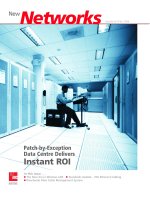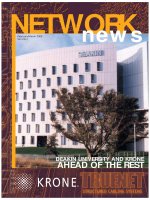Tài liệu ADC KRONE Network News - Vol.11 No.5 - 2004 pptx
Bạn đang xem bản rút gọn của tài liệu. Xem và tải ngay bản đầy đủ của tài liệu tại đây (700.06 KB, 16 trang )
Vol11 No5 2004
W
hile the corporate world is
embracing the next generation
network and taking advantage of
emerging IP applications to save costs
and streamline communications, these
new technologies are now beginning to
filter through to our homes.
There’s no doubt that home
networking has been heralded as the
next big thing, with a whole array of
applications now being made readily
available to the consumer. Inside this
issue, Rob Milne takes a closer look at the
emergence of the home networking
market in Australia, discussing the opportunities it
holds for a variety of parallel industries on page 4.
With the onset of home networking, it’s no
surprise, that KRONE, the most trusted name in
network cabling, with a wealth of experience in
structured cabling systems and installations in
literally every office in Australia, has developed a
solution for the home marketplace. Smart
Broadway, is designed to streamline the
convergence of these new technologies within
the home. Further information on the Home
Show and Broadway can be found on the back
cover of this issue.
On page 8, we continue to cover the theme of
future applications for emerging technologies,
with KRONE UK’s Mansel Healy discussing the
implications of new technology uptake within the
corporate arena, providing a timely warning to
those who may decide to wait on the sidelines
and be sadly left behind.
As a leader in new technology, our aim is to not
only provide future solutions to the marketplace,
but to also make them the best quality available.
It was therefore pleasing to have this confirmed at
the recent Victorian NECA awards where KRONE
featured as the vendor of choice for two award-
winning installers. Trevor Kleinert has the full
details on the awards in his article on page 3.
Finally, we review two corporations who have
recently installed KRONE solutions to meet their
future needs. On page 12, we feature the first
installation of our innovative Category 6 Angled
Patch Panel system at the NSW Audit Office,
followed by PMI Mortgage’s streamlined
HIGHBAND
®
25 solution.
Best of luck with this final quarter of 2004. May
the future technologies of tomorrow be providing
your business of today!
Sincerely
Craig Jones
Managing Director
2
{
NETWORKnews
THE FUTURE IS NOW
Consumers and corporations scramble to adopt new technologies
Customer Stories
12 New Angle Streamlines
Audit Office
14 PMI Insures Future With
A HIGHBAND 25 Network
Business Articles
4 Cabling The Home For An IP World
8 Cable Lagging Caution
11 Here’s The Drum About The TIN
KRONE News
3 Vendor Of Choice
13 KRONE Invests In Technology
Futures
15 Club KRONE End Of Year
Editor: Joanna Parsons
Art Direction: Nora Collins
Website: krone.com.au
Email:
CONTENTS
Copyright © 2001 KRONE Australia Holdings Pty. Limited
I
n late July KRONE was announced as the vendor
of choice at the Victorian NECA Awards in two
categories - under $500,000 Data Project and
over $500,000 Data Project.
Congratulations to endorsed installer,
Newscom, who primarily used KRONE’s
HIGHBAND
®
25 products for their winning
installation at NMIT (Northern Metropolitan
Institute of Technology) with Ideal as the supplier
in the under $500,000 Data Project category.
Commendations also go to Bell Technologies
who chose a KRONE HIGHBAND 25 system for its
winning installation at Toyota’s new corporate
headquarters, in the over $500,000 Data Project
category, again with Ideal as the supplier of the
product.
This, once again highlights the dominance of
KRONE Australia in the marketplace, not to
mention the continued success of HIGHBAND 25.
NEW FACES AT KRONE
With the recent promotion of Alex Price to the
position of NSW State Manager, I am pleased to
announce the appointment of Ade Croucher to
the position of Technical Sales Engineer. Ade will
be responsible for concentrating on both pre
and post-sales functions for the NSW and ACT
markets.
Ade is a CCNA (Certified CISCO Network
Administrator) and has a wealth of experience
and technical knowledge in the data
communications field and will, no doubt,
enhance our success in NSW.
I am also pleased to announce the appointment
of Jason Thiesfield to the position of Sales
Executive in our Queensland office. Jason has over
nine years experience in the telecommunications
arena and will be a solid addition to the
Queensland team, helping to further cement our
position as market leader. p
NETWORKnews
{
3
VENDOR OF CHOICE
KRONE cleans up at NECA Awards
By Trevor Kleinert,
RCDD, National Sales
Manager Premis
NET
,
Manager Fibre
Optics Division,
KRONE Australia
Jason Thiesfield
Sales Executive, Queensland
Ade Croucher
Technical Sales Engineer, NSW
NEW FACES
AT KRONE
E
ntertainment, security and access to
technological services within the home are now
clearly important purchasing decisions on the
minds of new home buyers according to a recent
HIA survey (see figure 1). Note the top three items
are security, pay TV and data/internet services.
And these are ahead of home environmental
solutions like air conditioning and heating. People
want to be secure and be entertained by that
which only new technologies provide.
Within the home the access to the “ triple play”
of voice, video and data from many rooms in the
house is now considered the minimum
requirement. Previously multiple phone handsets
was a driver for providing connectivity outlets to
most rooms, today it is access to broadband and
pay TV services, in addition to voice, which is
creating the need for more connectivity options.
Tomorrow Internet Protocol (IP) enablement of just
about every household device imaginable will fuel
the demand for increased network access in every
room.
Narrowband dial-up internet services which
previously limited the household to one PC in the
study, has given way to cheaper, higher
bandwidth broadband; enabling multiple PCs to
share the same connection. Australia now boasts
a 25 percent broadband penetration amongst
internet households and is currently the fastest-
growing broadband market in the world. The
wide range of internet content, services and
commerce, together with PC gaming and
educational requirements has created a need for
personal access to PCs by many household
members from different rooms. Once the second
PC arrives to share a broadband service, the need
for a home network exists.
Today there are a vast array of products
available for sensors, controllers and switches to
enable applications as diverse as heating, lighting,
security, watering, etc, for control of the home
environment and services. Most of those available
today are analogue or digital, non-IP based,
proprietary and non-standard. This causes
inoperability between devices and lower
production runs tend to make these devices
expensive. Being proprietary in nature such
systems require many specialist skills to install,
configure and maintain.
In the business world similar issues labelled as
“ islands of automation” found in older voice,
storage, video, security and processing
applications are being eliminated through the IP
enablement of devices and the deployment of
open standards. Now this wave of everything
moving to IP is about to embrace the home. Using
Ethernet and TCP/IP as the basis of network
connectivity allows devices to communicate easily
and efficiently with one set of rules and with a
communications interface that is both standard
and commodity; for both internal and external
communications. This industry move has in turn
opened up a whole range of opportunities for
“ smart” enabled devices, at a consumer oriented
price. We are now seeing IP technology appearing
in a range of home products as diverse as security
cameras, sensors, appliances, entertainment
systems, gaming consoles, lighting, HVAC and
environmental control systems. Investment today
in home, non-IP based, proprietary solutions
would indeed provide limitations for the future.
VoIP handsets are now available to home users
from ISPs and telecommunications providers
utilising their investment in their own IP enabled
backbones to make “ free” calls across their
4
{
NETWORKnews
CABLING THE HOME FOR
Future IP enablement of just about every household device imaginable will
fuel the demand for increased network access
By Rob Milne,
Business Development
Manager,
KRONE Australia
Consumer Preference for Home
Technologies When Building a New Home
Interested to Install
Security 100%
Pay TV 100%
Data/Internet 90%
Air-Conditioning 75%
Automatic Garden Sprinklers 70%
Smart Lighting 62%
Heating 60%
Audio System 50%
Figure 1
Source: 2004 HIA
research figures
network to other users and through agreements
with similar providers across other networks,
locally and globally. These providers also supply
the PSTN gateway for local “ offnet” calls. For the
first time, true competition in landline voice call
costs and services is now being made available via
technology rather than that determined
“ artificially” by government regulation. Coupled
with future video services in phones and
simultaneous access to the internet for display of
information on the phone, will provide a vast
array of creative service offerings. This can only be
good news for consumers.
Witness now the changes in music distribution
that will effect the way we listen to music in the
home or on the move. It started with the ability to
encapsulate music into computer based files such
as MP3 and move these easily across the internet
and private networks via IP. Then to music
storage and playback on large capacity, easy to
use, portable devices such as Apple’s iPod; for
10,000 songs in your pocket. And now to
convenient, cost effective, legal music purchase
via internet download directly to the PC or music
playback device using services like Apple’s iTunes
Music Store. Eliminating the middleman from
physical music distribution. The next logical phase
of this development will be direct enablement of
home entertainment systems for music import
and purchase, and for listening to internet radio
stations. Select a mood, and in comes all the
music you would ever need for an evening,
chosen from a global music catalogue, into any
device, in any room. How long before CDs go the
way of the vinyl record?
Following hot on the heels of music will be
video distribution, enter Video on Demand (VoD).
The ability to access movies and other video
services when desired, online from the home will
be the next major change in how content is
provided for home entertainment. Technology
has paved the way for TV signals to be
transmitted across DSL or fibre WANs using IP.
Delivery of video over DSL, FTTH and
MetroEthernet based IP networks will be by way
of one of two architectures; pure IP streaming
and IP over DSL. VoD will provide content
providers with a new distribution channel
providing additional revenue. At the same time IP
network operators have an opportunity to deliver
differentiating, high-margin, revenue-generating
video services. VOD services over IP networks will
grow to a total of more than 17 million users
worldwide, generating over $1.9 billion (US) in
subscription and pay-per-view revenue during
2006, according to In-Stat/MDR. As IP begins to
change video distribution and entertainment how
long before the DVD and the corner video store is
also relegated to history?
Again, like music, video based entertainment
and recording systems will be hooked into the
home’s TCP/IP network to receive IP based video
services and indeed many of these services will
provide for interactive video. Ethernet itself is
emerging as the new video backbone and
transport layer within local networks.
Connectivity costs for Ethernet can be ten times
lower than that of traditional analog video
routing and switching and it saves yet another
run of cables and non-IP standard connectivity
devices. To transmit video, which originates as an
analogue signal, over Ethernet and IP requires
video sources to be digitised, processed and
highly compressed into TCP/IP packets. Each
packet contains a lot of information regarding the
video signal. Delays in network transmission
(latency) and network errors resulting in packet
drop will quickly degrade the resultant video
information to be viewed. To implement real-time
video over Ethernet, a network must be in
excellent working order and the cabling system
and connectivity supporting the network must be
of the highest quality components with a high
standard of installation.
NETWORKnews
{
5
AN IP WORLD
" Australia now boasts a 25 percent broadband
penetration amongst internet households and
is currently the fastest-growing broadband
market in the world."
6
{
NETWORKnews
The industry move to IP unification of devices
and services provides for a standard network
infrastructure to carry the same communication
protocol to all devices. The rules for one device to
talk to another are clearly defined. The hubs and
switches required to route the information are
common place and commodity. Configuration
knowledge is common to all.
Wireless LANs have attracted interest as a home
networking alternative and as a supplement to
add additional services to a cabled solution.
Whilst wireless provides for useful mobility and
convenience of some networked devices within
the home and can provide easy to implement
point solutions for homes without a cabled
backbone, there are still many concerns regarding
wireless as a total home network service.
Bandwidth limitations, interference issues, short
ranges, constantly evolving standards and security
concerns, coupled with higher costs per device
make it difficult to standardise on one wireless
protocol across a myriad of devices within the
home. Wireless LANs are not suitable for
distribution of legacy applications such as basic
telephony, TV, or point to point connection of
certain equipment eg. remote control of
audio/video equipment. Certainly issues with
bandwidth, network latency and errors resulting
in packet drop, will make it difficult for wireless
networks to deliver high quality video and audio
over IP. All providers of IP enabled network
devices will provide the ubiquitous, standard RJ45
socket for 10/100Mb ethernet, but what variant
of wireless should they provide, if any?
Only a structured cabling solution provides for a
foundation that supports present and future
network technologies and services, which is both
reliable and provides for the lowest cost of
ownership. Wireless is still evolving, cabled
solutions are rock solid and stable. Installation of
a structured cabling backbone within a new or
renovated home is the only way to ensure true
investment protection for access to current home
automation systems and future IP enabled
services. A low cost, home Category 5 cabled
solution will provide for IP network bandwidths of
up to 1Gb/sec.
It’s difficult to tell how many devices will be
requiring access to future network services. How
many outlets should be cabled for each room? I
believe it’s a safe bet to at least look around a
typical room today, and any powered electronic
device you see now will tomorrow evolve into a
smart device obtaining benefit from a network
connection. Indeed, the devices themselves may
even obtain power from that same network
connection as Power over Ethernet (PoE) begins
its evolution from business and into the home.
That may seem like a lot of connections, but there
are probably new devices around the corner we
can’t envisage. Perhaps a safe rule might be,
consider how many outlets you need from the
above suggestion, and then double it. I figure you
can’t have enough and the opportune time to
install is when building or renovating.
A structured cabling solution has all of its cables
home run back to patch panels in a central
distribution point. This is a location where services
from outside the house such as ADSL, FTTH or cable
TV enter the home and are then distributed over
structured cabling using Ethernet and video hubs.
Clearly now the central distribution box is a
cornerstone of the cabled home. Not only does it
house the distribution panels, but also active
networking equipment and possibly security
equipment. On the shopping list might also be
other control devices for HVAC and even a micro
web server/firewall for remote access back to
Home Technologies Offered by Home Builders
Standard + Optional + Both = Total
Structured Wiring 34% 38% 6% 78%
Monitored Security 7% 50% 5% 62%
Distributed Audio 1% 52% 4% 57%
Home Theatre 1% 5% 3% 55%
Automated Lighting Control 0% 28% 3% 31%
Energy Management 0% 28% 3% 31%
Home Automation 0% 24% 3% 27%
Source: US Consumer
Electronics Association
figures (statistics apply only
to US market)
" Only a structured cabling solution
provides for a foundation that
supports present and future network
technologies "
NETWORKnews
{
7
installed IP devices for monitoring and control.
KRONE’s new, larger Smart Broadway home
distribution panel, provides the ideal solution for
home network distribution with enough space for
current and future devices, and can optionally be
expanded to accommodate up to 128 patch points;
the largest capacity in the industry. All using industry
standard, high quality KRONE connectivity
components. The expandability, capacity and low
cost also makes the Smart Broadway an ideal
network distribution solution for small offices, shops,
branch locations and professional premises without
having to go to a full 19” rack.
Home networking will provide a tremendous
opportunity for the structured cabling
installation and services industry. The launch of
the Smart Wired Project in Australia by the
Copper Development Centre (CDC) followed
from recognition that “ technology in the
home” was going to be the next big trend, and
this was supported by surveys such as the
Consumer Electronics Association survey carried
out in the US. A survey by the CEA in January
2003 found that in 71 percent of new homes,
builders saw home technologies as more
important now than they were 2 years ago. The
Smart Wired initiative in Australia recognised
the need to have a standardised protocol on
which all these new home technologies would
“ plug and play” and that the solution should be
affordable and reliable. The CDC have been
working with industry partners NECA and CEDIA
to introduce one accreditation for an electrical
contractor to be able to install cabling for data
garden irrigation, audio visual and security
solutions. Allowing installations to occur cost
effectively in a new or renovated home at the
same time the power cables are pulled.
The implementation of IP within the home will
become the glue to making low cost, highly
functional smart enabled devices in the home a
reality, structured cabling will be the foundation
and consumers are providing the demand.
Therein lies the opportunity for installers already
experienced and accredited in structured cabling
installations. With at least 160,000 new homes
and units forecast to be built in Australia during
2004/05 and a $20 billion renovation market, I
say go to it!
The home entertainment and high technology
boom is well under way in most advanced and
emerging countries and IP convergence in the
home will only fuel that boom further. Even now
in Japan, NTT, Fujitsu and the Japanese
government are forming a working group to
develop internet technologies that will allow
homes to receive 10 Gigabit internet connections
by 2010 to satisfy the demand! p
BROADWAY
Home Gateway to Broadband Services
T
hings are seldom what they seem. Mention
high-speed networking and it’s the
applications that first spring to mind. Next come
thoughts of storage area networks plus the new
switches and servers, then the technicalities of
equipping PCs and workstations with new NICs or
network interface cards. Likely or not, the actual
cabling infrastructure that underpins this new
connectivity is virtually an afterthought. Given
that to most people structured cabling is
somewhere near last on the list, this is entirely
understandable.
It’s also unfortunate, because the last thing that
IT professionals want is the functionality of the
cabling system lagging that of the active systems
that depend on it - and ruining their performance.
In fact it’s easy to demonstrate that the
technology of the structured cabling you are
installing needs to precede the deployment of the
active equipment it will eventually be called upon
to support - by between four and six years! If this
sounds surprising, let me justify my assertion and
explain why IT professionals need to consider the
far-off future right now.
IT’S THE LAW
If we look back over history, there is an
observable cycle from which has grown the
dominance of Ethernet, driving IT managers
constantly to seek
“
future proof” solutions.
Moore’s Law states that computing power
doubles every 18 months and whilst active
equipment and cabling were not specifically
included, his edict clearly has a powerful influence
on its replacement. Active equipment has a life
span of roughly four years; the last major change-
out was in 1999, anticipating Year 2000 issues.
The next cyclical change-out is a little overdue but
it’s starting to happen now as 10/100Mbit/s
switches and equipment are being jettisoned for
Gigabit/s actives.
Now I’ll give you Healy’s Law, which states that
passive always leads active, causing IT managers
as much grief as Moore’s Law. Computers are
being replaced every two to four years, actives
every four years. Yet the cabling infrastructure -
largely because of the disruption its installation
causes rather than its actual cost - is expected to
last five, eight, 12 years or more
OUTLANDISH
The only realistic solution then is to install
structured cabling that’s so advanced that its
capability will lead that of the active equipment
for several years. And this just has to mean 10
Gigabit/s Ethernet, however outlandish it may
appear now, when most desktop networking is
barely at the 1 Gigabit/s stage. Connectivity
manufacturers do not develop new systems out
of self-gratification, they respond to user needs
and whilst only fibre active equipment really has a
requirement for 10Gbit/s data rates right now,
actives with 10 Gigabit/s Copper NICs will come
along within the next couple of years.
(Remember, Gigabit/s was once said to be for
8
{
NETWORKnews
CABLE LAGGING CAUTION
Delaying deployment of 10Gbit/s networking could be an expensive way of
saving money, argues Mansel Healy
By Mansel Healy,
Marketing Director -
Enterprise Networks,
KRONE UK
The only realistic solution then is to install structured
cabling that’s so advanced that its capability will lead
that of the active equipment for several years.
servers and high end use only and now nearly
every box ships with a Gigabit/s NIC!). And, since
most IT managers have the opportunity to cable a
building or floor only once every seven to ten
years, you need to seize any opportunity to
futureproof your installation.
Critics will argue that 10 Gigabit/s Ethernet is
exclusively for power users and early adopters, also
that it’s premature to consider installing 10Gbit/s
cabling before any standards have been set.
These statements do not stand up to scrutiny.
IT managers know that 10 Gigabit/s Ethernet is
coming and understand very well the cost-benefit
advantages of early business rewards versus
deployment costs. Agreed, in an ideal world every
user would strive for standards-based networking
solutions but the practical need for cabling
installations to lead active equipment deployment
has forced users to adopt technology in advance
of standardisation. Category 6 is a case in point:
the world began installing it three years before a
ratified standard appeared.
ALTERNATIVE OPINIONS
Although the eventual need for 10Gbit/s
networking is widely agreed, opinions vary
whether copper cables are the ideal solution.
Some proponents believe that fibre is the only
way forward and from an engineering standpoint
fibre is of course a superb solution, but the high
cost of fibre NICs means that economically,
copper will win the day.
Right now there is also talk of ultra wideband
wireless techniques that could deliver equal
connectivity with far greater flexibility than any
fixed cabling and some users may be tempted to
wait for these. My view is they can, if they can
afford to take the risk. Wireless LANs are
undoubtedly increasing in popularity and indeed
capability. They seem likely to always lag copper
and fibre in terms of data rate capacity, however,
and the difficulty in managing the security aspects
of WLANs mitigates against wireless replacing
copper or fibre for the majority of users.
Moreover, it is highly unlikely that WLANs will
achieve 10Gbit/s data rates in the lifetime of
10Gbit/s copper systems.
NETWORKnews
{
9
most IT managers have the
opportunity to cable a building or
floor only once every seven to ten
years, you need to seize any
opportunity to futureproof your
installation.
LAUNCH
On the other hand, there is no technical obstacle
to implementing 10Gbit/s networking right now,
following my company’s recent launch of
CopperTen
™
, an augmented Category 6 UTP
system. So what should users do? Sit back and
adopt a wait-and-see approach, continuing to
install to current standards? Or should they try to
employ strategies that will help protect them
when 10 Gigabit/s networking hits the desktop?
There’s no simple answer actually. If they don’t
need to deploy a new network or extend their
existing one, there’s something to be said for
waiting. But in reality few network managers
have static networks and all major enterprises will
derive early return on investment by deploying 10
Gigabit/s Ethernet now. History shows that
eventual standards seldom diverge significantly
from early implementations.
In any case, the 10 Gigabit/s copper cabling
offered right now conforms fully to Category 6
standards, so it’s not as if this investment would
be squandered. Already one major international
financial institution has taken this point on board
and installed CopperTen, because, says its
network manager it represents the lowest risk
strategy of all.
Considering the need for future-proofing, the
early benefits and minimal risk involved, the
arguments in favour of deployment are all
positive. The sole question is how soon this will be
feasible given each user’s individual
circumstances.
THE FUTURE IS COPPER-COLOURED
One last point I need to make clear is that I am
not advocating a move away from fibre, which
continues to have a clear role to play in the
backbone, across the campus and in some
horizontal applications. At this stage, however,
most network managers favour UTP copper for
the horizontal runs to users’ desks and
workstations - which is exactly why we developed
CopperTen.
Unless the installation is already fibre-focussed,
it is simpler to install augmented Category 6 UTP
now and use today’s active equipment with its
ready-fitted 10/100/1000 NICs, knowing that the
same cabling will handle 10Gbit/s when this
becomes a user requirement in three, five or seven
years time. What’s more, once 10Gbit/s NICs start
to be produced, they will fall rapidly in cost and
become fitted as standard. Since most
organisations find the opportunity to cable a
building or floor only once in every seven to ten
years, it makes sound sense to deploy 10Gbit/s
copper cabling for data intensive networks as early
as possible in order to futureproof the installation.
Mansel Healy is Marketing Director for Enterprise Networks in
Europe, Middle East and Africa with KRONE, the world-leading
cable and connectivity company, recently acquired by ADC, with
75 years of experience in the design, development and supply of
copper and fibre optic cable and connectivity solutions for
enterprise and public networks.
p
10
{
NETWORKnews
T
he TIN is a
Telecommunications Infringement
Notice
and it is set to become the new vehicle
for the delivery of a penalty in lieu of prosecution
for non-compliant cabling work and/or cabling
products.
The Australian Communications Authority
(ACA) is responsible under the
Telecommunications Act 1997 for ensuring
compliance to the Technical Regulations under
the Act. The ACA generally takes a graduated
approach in encouraging compliance with
technical regulations. In the first instance, this
usually consists of the ACA advising the alleged
offender of the breach and of the steps needed to
comply with the relevant requirements. An official
warning may also be issued to the alleged
offender.
If this action is unsuccessful, for certain
breaches of the Act, the ACA can escalate its
regulatory action by issuing the alleged offender
with a Telecommunications Infringement Notice
that sets out the nature of the offence, the
penalty amount payable and the maximum
penalty a court could impose for the offence. In
instances where the alleged offender has a record
of recurring or serious non-compliance, the ACA
may choose to immediately apply an escalated
regulatory action.
Authorised ACA officers can issue a
Telecommunications Infringement Notice with an
associated monetary penalty to an individual or
body corporate that has committed an offence in
lieu of having the matter heard in a court.
If a penalty is paid within 28 days after the
notice is served, the matter is disposed of without
an admission of guilt or a conviction.
Some of the offences (and there are others)
that may attract a Telecommunications
Infringement Notice are:
1. performance of unauthorised cabling work;
2. breaching the Telecommunications Cabling
Provider Rules 2000;
3. connection of unauthorised telecom-
munications equipment or installation of
unauthorised cabling products.
EXAMPLE
If an individual performs unauthorised cabling
work, a Telecommunications Infringement Notice
would impose 12 penalty units (currently $110
each = $1,320) for each offence. A body
corporate would have 60 penalty units ($6,600)
imposed for each offence.
In contrast, the maximum penalty that a court
may impose on conviction of the offence is 120
penalty units ($13,200).
If you receive a Telecommunications
Infringement Notice and you don’t believe you
have committed an offence, you can provide a
statement in writing within the 28-day period,
outlining the reasons you believe demonstrate
that you have not committed an offence.
If the decision is made not to withdraw the
Telecommunications Infringement Notice,
reasons will be provided and you will then have a
further 7 days to pay the penalty.
This industry news comes, with permission,
from an ACA Industry Fact Sheet.
For more detailed information, visit
www.aca.gov.au/standards_compliance.htm. p
NETWORKnews
{
11
HERE’S THE DRUM ABOUT THE TIN
Peter Meijer demystifies the Telecommunications Infringement Notice
By Peter Meijer, JP BE
MSc, RCDD,
Technical Training
Manager and Industry
Liaison,
KRONE Australia
T
he Audit Office of New South Wales supports
the Auditor-General by providing audit and
related services to the NSW Parliament.
The Audit Office plays a crucial role in ensuring
an efficient, effective and accountable public
sector. To do this, the Office audits over 400 New
South Wales government agencies to assure
Parliament that financial reports are prepared
correctly. These agencies range from large
statutory authorities and departments to small
subsidiary companies.
This role also includes assessing how well
agencies comply with a selection of legal
requirements and government policies as well as
investigating allegations of serious and substantial
waste and conducting assessments of whether
agencies achieve value-for-money.
The Auditor-General regularly reports to NSW
Parliament on the results and recommendations
of the various audits and reviews.
A recent relocation of the Audit Office to new
premises meant the installation of a new
structured cabling system and the opportunity to
improve on their existing network set-up of
standard 16-port patch panels in somewhat less
sturdy cable management units.
To meet their requirements, the Audit Office
sought a solution that would provide neat and
efficient management of their high-density 48-
port switching units. This need prompted
endorsed installer, Computer Integrations to
supply information on KRONE’s Category 6
Angled Patch Panel as a possible solution.
The KRONE Angled Panel is designed to improve
the efficiency of 19” data cabinets by neatly
directing patch cords to either side of the rack,
preventing the occurrence of tangled cords and
simplifying any adds, moves and changes. The
angled ports also maintain the specified Category
6 bend radius of patch cords, preventing possible
signal failure caused by over bent patch cords.
The Audit Office’s decision to install the 24-port
angled patch panels and cable management units
was based not only on KRONE’s reputation for
reliability but the innovative design of the patch
panel solution and the efficiencies it offered.
Installer, John Cook from Computer Integrations
explains, “ By utilising the angled patch panels
and patch cord management arms, the Audit
Office was able to reduce the space required in
their communications cabinets.”
12
{
NETWORKnews
NEW ANGLE STREAMLINES AUDIT
KRONE’s Angled Patch Panel installation at the New South Wales Audit Office
has helped reduce space and streamline network communications
By James Oliver,
Sales Executive,
KRONE Australia
“ By utilising the angled patch panels and patch cord
management arms, the Audit Office was able to
reduce the space required in their
communications cabinets.”
KRONE’s Angled
Patch Panel
solution.
The Audit Office of New South Wales
new premises.
The Angled Patch Panel solution was installed
during the Audit Office’s four-week cabling fit out
throughout the two floors of their new premises.
Comprising a total of 650 ports, the installation
went to plan, however Mr Cook said the project
had a very tight timeframe and was also the first site
in Sydney to install the angled patch panel system.
Mr Cook said, in order to meet the deadline,
KRONE was able to deliver the products directly
to the site via distributor Page Data.
On completion of the installation, The Audit
Office’s IT department were particularly
impressed by the neat appearance of the
installed panels and innovative cover labels
concealing patch cords.
The use of the patch cord management arms
and cover labels not only conceals the patch cords,
it allows IT staff to locate a patch panel port
without moving patch cords to view the label.
To date, the Audit Office’s IT Department has
reported that the KRONE Angled Panels are
performing well, playing an important role in a
neat, easy to maintain network that is responsible
for providing services to 220 staff. p
NETWORKnews
{
13
KRONE INVESTS IN
TECHNOLOGY FUTURES
OFFICE
T
he recently established Technology Futures Centre is a unique,
state of the art facility conveniently located on the senior campus
of Brisbane Water Secondary College. Its primary purpose is to provide
IT education and training to college students, but it is also available for
use by community groups, commercial organisations and training
operators.
To help support the costs of providing the centre, the Brisbane Water
Secondary College has sought to establish partnerships with leading
companies from the IT marketplace. KRONE, who has a long history of
supporting community-based education, has generously become a gold
sponsor providing funding and equipment for the facility.
It is envisaged that KRONE’s sponsorship of the Technology Futures
Centre will assist Brisbane Water Secondary College in their aim to provide
IT related vocational education using the latest techniques and equipment.
Commenting on the sponsorship, Craig Jones, Managing Director of
KRONE Australia said, “ It is important to support the education of our
youth especially in the area of information technology. KRONE has for
many years helped to fund such projects, particularly on the Central
Coast where our manufacturing facility is located” .
Further information regarding the Technology Futures Centre is
available at www.techfutures.ccoast.org. p
The Audit Office’s Peter Auld
inspects the new system.
P
MI Mortgage Insurance Ltd is a leading
mortgage insurer, credit enhancer and
residential property market specialist with a
commitment to product and technology
innovation and over 35 years experience in the
Australian market.
PMI is one of the largest mortgage insurers in
Australia, providing a variety of risk management
products to banks and other mortgage lending
institutions, with coverage against potential losses
arising from defaults on residential mortgages.
PMI has facilitated home ownership for more
than 860,000 families in Australia and New
Zealand and is a subsidiary of The PMI Group, Inc,
a global credit enhancement provider with
operations in the United States, Australia, New
Zealand, Hong Kong and Europe.
PMI’s national head office in Sydney recently
faced upgrading a system that had become
difficult to manage. Simple procedures such as
moves, adds or changes or locating the source of
a problem within the network were extremely
time consuming for IT support staff.
To address these issues and plan for future
requirements, PMI undertook the installation of a new
communications room located on a separate floor.
Mr Reg Bateup, IT Customer Service Team
Leader for PMI explains, “ Our previous solution
was just not suitable, over time the network had
outgrown its original design and we therefore
needed something better” .
The main prerequisites, outlined by PMI for the
new system, were flexibility, scalability and
simplicity. “ We needed the flexibility to be able to
provide any combination of voice and data service
to workstations. We also required a solution that
would be tidy and easy to maintain. The system
had to be scalable too so that we would not be
cramped or limited by any future growth,” said
Mr Bateup.
PMI’s preferred installer, ACC Technologies,
initially recommended KRONE’s HIGHBAND 25 as
a possible solution to meet their growing needs.
PMI were particularly impressed by KRONE’s
ability to visit on site and demonstrate the
benefits of HIGHBAND 25 with interactive
models. Mr Bateup said KRONE had also provided
reassurance with an option to visit HIGHBAND
installations and speak to existing users of the
product.
As a result, PMI chose a KRONE HIGHBAND 25
Patch By Exception solution as the most suitable
for their requirements.
Category 6 compliant HIGHBAND 25 is an
integral part of the KRONE Premis
NET
®
solution
featuring TrueNet
®
technology, zero bit error
performance, and superior cable management.
Supporting the need for high-density cross-
connect cabling and emerging
applications such as 10 Gigabit
Ethernet, VoIP and broadband.
The HIGHBAND module is the basis
for KRONE’s “ Patch By Exception”
(PBE) methodology. PBE is where
hard wiring is used to connect
circuits. This hard wiring can then be
over-ridden by a patch cord, making
patching the exception rather than
the rule. Creating a system that is
flexible, space saving, cost effective
and easy to manage.
After a seamless installation by
ACC Technologies, HIGHBAND 25 is
now the backbone of an upgraded
14
{
NETWORKnews
KRONE provides “ patch happy” PMI with a flexible, easy-to-maintain network
solution
PMI INSURES FUTURE WITH
A HIGHBAND
®
25 NETWORK
By Jeremy Barnes,
Sales Executive,
KRONE Australia
From network
nightmare to
streamlined
performance!
ããã
PMI network consisting of two floors interconnected
with fibre, using Category 6 to provide voice and data
services to office workstations. All workstations contain
three individual RJ45 outlets that are labelled A, B and
C, each with a different identifying bezel colour. As a
standard PMI use A for data, B for voice and C as a
spare. At times additional services are required at work
bays and PMI are able to quickly patch (for example a
temporary PSTN service) to Port C with very little effort
at all.
Mr Bateup commented that the final appearance of
the HIGHBAND 25 installation was very professional,
“ The operations support staff have found the solution
extremely tidy making it easy to manage and administer
and with the use of the PBE leads, we are free to patch
what we want, when we want” .
To date, PMI have reported that the HIGHBAND 25
solution is performing well, supporting a network that
provides voice and data services to approximately 140
users within the PMI office.
When asked about the outlay associated with
implementing the new solution, Mr Bateup said it had
been comparative when compared to the costs and loss
of efficiency that had been incurred by PMI while trying
to maintain the previous system.
HIGHBAND 25 has successfully reduced the amount
of time PMI spend managing their voice and data
network, “ It is now visually clear and logically laid out
making it simple to administer. We have the flexibility to
move services when we want, to where we want,
allowing us to meet our internal customers requirements
faster” , said Mr Bateup. p
NETWORKnews
{
15
Y
et again, another year will be
drawing to a close, and I hope it
has been as successful for you as it
has for Club KRONE.
Throughout the year we have seen
lots of new and existing members
taking advantage of the scheme’s
benefits by redeeming their points for
KRONE products or courses through
our training provider, J B Hunter
Technology.
With this in mind, I wanted to take
this opportunity to remind you all that
the current Club KRONE year will
finish on the third Friday in November
(19 November).
All Club KRONE redemptions must
be received before the close of
business on the 19 November for
processing. Any unused points or
redemptions received after this date
will be forfeited.
The new Club KRONE year will
commence on 20 November 2004 at
which time you can submit your
invoices from this date onwards for
inclusion against next year’s account.
I plan to keep all members informed
of their individual points total by
supplying regular updates before the
cut-off date.
Should you have any questions,
please do not hesitate to contact
me. p
CLUB KRONE
END OF YEAR
By Mark Meyer,
Club KRONE Manager,
KRONE Australia
Change the way you live your life
with SMART BROADWAY
From the most trusted name in the industry . . .
a networking solution for your home!
î
À
î
Â
î
¹
î
Ä
î
Š
î
*
Only a structured cabling solution will provide the foundation
to support present and future network technologies.
Conveniently link rooms with phone, fax, computer, cable broadband
and free-to-air or pay TV capabilities and make entertainment work
for you, when and where you need it.
6 Versatile entertainment that suits all your needs
6 Neat, streamlined performance
6 Eliminate messy cables, unsightly plugs and boxes
î
À
î
Â
î
¹
î
Ä
î
Š
î
*
Call us Toll Free 1800 801 298
SMART BROADWAY — your home networking solution!









